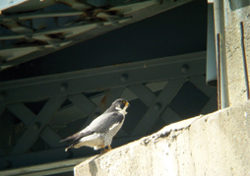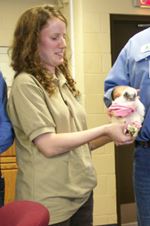



Life in the fast lane
Rare
birds nesting on
Milton-Madison bridge present
unique challenge for crews
There
are only eight pairs
of Peregrine falcons in Kentucky
By
Konnie McCollum
Staff Writer
(May 2009) – When Asa Crane migrated to this
area, he scouted for the perfect spot to make a home and landed, literally,
on the Milton-Madison Bridge across the Ohio River. Asa and his partner
are Peregrine Falcons, a rare species that at one point was on the federal
Endangered Species List.
 |
|
Photo
provided Asa
Crane nests with his mate |
Since 2003, the pair has made their nest on the bridge.
Recently, when geotechnical crews from the Kentucky Transportation Cabinet
were testing the bridge piers for a possible superstructure replacement,
they carefully maneuvered around the birds in an effort to not disturb
them.
“We worked with the transportation crew to help them avoid disturbing
the birds during their nesting,” said Kathryn Heyden, an avian
biologist with the Kentucky Department of Fish and Wildlife Resources.
“While the Peregrine Falcons are no longer on the endangered list,
they are still protected by the National Migratory Bird Treaty Act and
it is illegal to destroy their nests.”
Powerful and fast-flying, the Peregrine Falcon, about the size of a
large crow, hunts medium-sized birds, dropping down on them from high
above in a spectacular stoop. Virtually exterminated from eastern North
America by pesticide poisoning in the middle 20th century, restoration
efforts have made it a regular, if still uncommon sight in many large
cities.
Technicians working on the bridge found the nest in the same spot it
has been in every year since the birds perched there. This year, Heyden
set up a box for them on a pier, and they moved right into it. She said
technically, the birds live in Kentucky and are among only eight known
pairs in the entire state. Indiana has several more pairs of nesting
falcons than that.
The falcon couple is currently incubating several eggs. The fledgling
birds will stick around the nest until July or August and then be totally
on their own. Repairs to the bridge are slated to begin sometime after
the fledglings fly the coop.
Before the baby birds get big enough to leave their parents, Heyden
said they will be banded so they can be tracked for further research.
Once banded, they are often named. “The reason Asa Crane’s
partner doesn’t have a name is because we haven’t been able
to band her,” said Heyden. “We believe she is the same mate
he has always had, as they usually partner for life, but we just don’t
know for sure.”
 |
|
Photo
provided Avian
biologist |
Volunteers in the community keep a watchful eye on the
family for wildlife officials.
“Because they were wiped out in this part of the country, it’s
a very big deal to have this pair of Peregrine Falcons nesting on our
bridge,” said Kelly Misamore, a naturalist for more than 25 years
and owner of The Birdhouse, 108 E. Main St. “It’s like having
a rock star or celebrity here.”
Dan Matiatos, a biologist at Big Oaks National Wildlife Refuge, said
lots of people are interested in the birds and go down to watch them.
“This situation is just not really common,” he said. “The
birds were on the brink of extinction, and now there is a breeding pair
living in the community. It’s a unique situation.”
Dick Davis, park naturalist for Clifty Falls State Park in Madison,
Ind., said in the wild, the falcons nest on the edge of cliffs. “The
bridge is a good replicate of a natural site. In larger cities, the
birds are being successfully re-introduced and have made their home
on the edges of skyscrapers.”
Although Asa Crane and his mate have been in the area for several years
and have had two to four fledglings make it each year, no known offspring
of the couple have set up their own nests in the area.
Davis said it is because, while Clifty Falls State Park has the appropriate
landscape, one of the major predators of the falcons, the Great Horned
Owl, is common throughout the area. There are Great Horned Owls known
to live in the park.
“They prey upon young Peregrine Falcons in their nest,” he
said. “The bridge is a safe place for the pair because Great Horned
Owls are not likely to be out roaming around near it.”